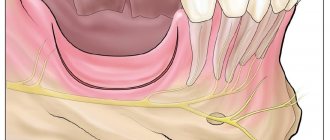What is hand numbness and its causes?
Many people are familiar with the unpleasant feeling of tingling, “crawling on the skin,” as well as pain, decreased sensitivity and deterioration of mobility in the limb. All of these manifestations characterize numbness, which can occur in the arms, legs and other areas of the body. It is associated with impaired blood circulation in the tissues or compression of the nerves.
Along with numbness in the hands, the following symptoms may also occur:
- burning sensation;
- muscle spasms;
- tingling sensation;
- pain in hands, fingers;
- feeling of itching;
- tingling and numbness that gets worse when you move your fingers;
- increased sensitivity to touch;
- pain in the cervical spine.
Why your hands go numb at night: reasons
Usually the problem affects a specific area of the limb. Etiological factors are:
- rheumatoid arthritis, osteoarthritis of the hand joints;
- carpal syndrome, which develops with monotonous regular exercise - playing the piano, working as a sign language interpreter, playing e-sports. The entire hand or the area below the wrist becomes numb;
- diseases of the cervical spine: osteochondrosis, accompanied by protrusions or hernias in the C6-C7 segment, tumors, inflammatory processes, neuroinfections. The localization of unpleasant sensations depends on the location of the inflamed root: C5 - along the lateral part of the arms, C6 - the back of the index and middle fingers, forearm, shoulder; C7 - back of the shoulder to the fourth and fifth fingers.
If your hands go numb at night, the reasons may relate to metabolic disorders. In diabetes mellitus, this is diabetic neuropathy associated with impaired transmission of nerve impulses and fibrosis of connective tissue structures. Damage to the periphery of the nervous system also occurs in the later stages of alcoholism due to metabolic disorders and axonal demyelination. In these cases, symmetry is characteristic; the hands become numb during night sleep, starting from the lower areas, gradually rising as the vascular damage spreads.
In case of heart disease, numbness on the left side may be a symptom of an angina attack or a heart attack. If discomfort lasts more than 15 minutes, radiates along the inner surface of the limb, to the shoulder girdle, neck or jaw on the left, consult a doctor immediately.
Causes of numbness in the left hand:
- Cardiac ischemia. In addition to numbness in the left arm, there is discomfort in the chest. If after taking nitroglycerin or stopping the physical activity that caused the symptoms, these manifestations disappear, then it is angina pectoris. In addition to numbness of the left arm, it is accompanied by chest pain in the heart area, panic, pale skin, nausea, shortness of breath, and cold sweat.
- Myocardial infarction. Sometimes hand numbness is the only sign of this acute cardiovascular disaster. During an attack, the patient experiences intense pain and a feeling of constriction in the chest, shortness of breath, and interruptions in the functioning of the heart. The skin becomes covered with cold sweat. Along with numbness in the hand, a person experiences pain radiating to the lower jaw, stomach, and the area between the shoulder blades.
- Atherosclerosis. Due to atherosclerotic damage to the blood vessels, decreased strength and numbness in the arm may occur. Symptoms intensify when raising the limb upward.
- Stroke. Numbness in the left hand may indicate damage to the right hemisphere of the brain. In this case, the upper and lower limbs on the left side become numb, vision and speech are impaired. Along with numbness in the hand, a stroke can cause a complete loss of sensation in the hand. Other symptoms of cerebral hemorrhage include weakness in the limbs, loss of coordination, severe headache, blurred vision, nausea and vomiting, and irritation from bright lights and sounds.
- Vegetative-vascular, or neurocirculatory dystonia. This is a complex of autonomic disorders that is associated with disorders of nervous regulation. In addition to numbness of the left hand, it may be accompanied by headaches, insomnia, pressure fluctuations, arrhythmia, and panic attacks.
- Raynaud's disease. The pathology is accompanied by paroxysmal circulatory disorders in the arteries of the extremities. Along with the numbness of the hand, its rapid freezing is felt. In the cold and with excitement, a person’s fingers may turn blue. As Raynaud's disease progresses, not only the hands become numb, but also the legs, chin, nose, and ears.
- Vitamin B12 deficiency. This connection is extremely important for the normal functioning of nerve tissue. With its deficiency, a person not only experiences numbness in the hand, but also suffers from dry mouth and pale skin.
- Osteochondrosis (usually cervical and thoracic). First, the fingers go numb, then weakness develops in the upper limb, and the grip strength of the hand decreases. Sometimes pain is felt along the outside of the shoulder and forearm.
- Overstrain of muscles in the cervical-collar region. Pianists and PC operators suffer from hand numbness due to prolonged maintenance of the same position. The problem lies in the overstrain of the muscles, which compress the nerve fibers responsible for the sensitivity of the limbs.
- Insufficient blood circulation. The upper limb becomes numb due to impaired blood flow due to damage to the walls of blood vessels, for example, in diabetes mellitus.
- Stress and psycho-emotional overload can cause hand numbness.
- Carpal tunnel syndrome. When the median nerve passing through the wrist is compressed, the left hand may become numb. This problem is familiar to people of certain professions (programmers, musicians). Nerve compression can also occur in women during pregnancy due to swelling, as well as in patients after surgery, in obese people.
What other diseases cause numbness in hands, feet and tongue?
Lesions of the cervical, cranial, and lumbar nerves can cause numbness. But in addition to this, other symptoms are usually present: pain, tingling, dysfunction (claudication, arm weakness, slowness and blurred speech).
Metabolic diseases can also cause changes in sensitivity, including numbness of body parts. If you often limit yourself to meat, fish, eggs, and do not supplement your diet with synthetic vitamin B12, then this can cause metabolic disorders and cause weakness in your arms and legs.
Loss of sensation in the left hand may be one of the classic symptoms of myocardial infarction. At the same time, the general condition worsens, the person looks very pale or, on the contrary, turns red, dizziness or headache, a feeling of heaviness in the chest or a burning sensation appears.
A hernia in one part of the spine can put pressure on a nerve, causing pain or loss of sensation.
Decreased sensation in the feet can be a complication of diabetes. This is one of the first signs of diabetic foot and should be reported to your doctor as soon as possible.
Numbness in the right hand may have the following causes:
- impaired blood flow, pinched nerve due to incorrect position of the limb (for example, during sleep);
- staying in an uncomfortable position for a long time (may be due to the nature of the work, for example, carpal tunnel syndrome);
- frequent carrying of bags, suitcases and other heavy objects;
- long exposure to frost or in a cold room;
- long-term muscle tension of the upper limb.
Causes of numbness in limbs
Numbness of the limbs can occur due to pathological processes in the peripheral nerves, in the presence of disorders in the spinal cord and brain. Numbness can occur with:
- Vasculitis or stroke, they worsen, block the blood supply to the nerves.
- Injury or neuropathy of the sensory pathway.
- Compression on any part of the route.
- Nerve infections (leprosy, HIV, Lyme disease).
- Inflammation or destruction of the outer layer of nerves.
- Metabolic disorders (diabetes, heavy metal or toxin poisoning).
It is also worth paying attention to excessive pressure on the nerves, repeated for a long time, for example, crossed legs when sitting. Narrowing of the lumen in the spinal canal, osteoarthritis, damage to the intervertebral discs. Pressure near the spinal cord due to a tumor, hematoma, or damage to the spinal cord due to trauma. Only a neurologist can more accurately determine the cause of numbness. The following are common causes of numbness in body parts:
- The head area and areas of the face may become numb due to: fungal infection, glossopharyngeal neuralgia, herpes zoster, trigeminal neuralgia, stroke, migraine and osteochondrosis.
- The torso area becomes numb in the presence of: suspicion of radiculitis, intercostal neuralgia, coronary heart disease, pathologies of the genitourinary system, kyphosis.
- Hands may go numb due to: diseases of the spine, diabetes and intoxication, disturbances in the functioning of the heart.
- Fingers may go numb due to: a hernia in the spine, hand injury, heart disease, carpal tunnel syndrome.
- Legs and toes go numb with: the presence of hernias, cauda equina syndrome, osteochondrosis and pinched sciatic nerve. Various types of varicose veins, atherosclerosis and arthritis may be present.
Why does hand numbness occur?
When a patient says that his upper limbs are numb, he may mean:
- a tingling feeling that causes discomfort;
- sensation of “goosebumps” under the skin;
- decreased sensitivity of the skin.
Numbness of the hands does not always indicate pathology. It may be the result of wearing too tight clothes and jewelry that compress blood vessels and nerves.
The most common causes of numbness in the hands:
- Uncomfortable body position, monotonous mechanical work, disrupting blood flow. After changing the position of the limb, the unpleasant sensations disappear.
- Carpal tunnel syndrome (usually affects the working hand due to prolonged monotonous work).
- Atherosclerosis. Accompanied by tingling and numbness of the hands, in the future a decrease in their muscle strength is likely.
- Osteochondrosis of the cervical spine (numbness, usually symmetrical, may intensify after physical activity).
- Diabetic neuropathy (usually both hands go numb).
- Intervertebral hernia in the cervical region (numbness is associated with compression of the spinal nerve roots).
- Ischemic stroke of the brain (threatens numbness and paralysis of the arm).
- Multiple sclerosis (if part of the postcentral gyrus of the brain is affected, the limbs may go numb).
- Thoracic outlet syndrome (compression of nerve trunks and blood vessels in the area of the upper chest opening).
- Brachial plexitis (numbness of the arm occurs due to inflammation of the brachial plexus).
- Damage to peripheral nerves due to alcoholism (alcoholic polyneuropathy).
- Brain tumor (the formation can compress the motor and sensory neurons responsible for the innervation of the upper extremities).
- Raynaud's disease (a disorder of the innervation of small arterioles, more common in women, manifested by numbness and pain in the extremities).
- Rheumatoid arthritis (inflammation and deformation of joints leads to compression of nerve fibers) and others.
Main services of Dr. Zavalishin’s clinic:
- consultation with a neurosurgeon
- treatment of spinal hernia
- brain surgery
- spine surgery
Possible causes of hand numbness
For what diseases do patients most often complain of numbness in their hands? The reasons leading to this situation are sometimes hidden in the most common diseases.
| Disease | Paresthesia of the right hand | Paresthesia of the left arm | Associated symptoms |
| Spinal diseases | + | + | Tinnitus, neck crunch, dizziness, pain in the neck, forearm, blurred vision, paresthesia of the legs |
| Heart diseases | _ | + | Chest pain, anxiety, shortness of breath |
| Cerebral ischemia/stroke | + | + | Dizziness, nausea, swaying when walking, disturbance of spatial orientation |
| Joint diseases | + | + | Joint inflammation, swelling, aches, pain |
| Carpal tunnel syndrome | + | + | Aches, pain in the wrist |
Diagnosis of the causes of hand numbness. How to identify?
At the appointment, the doctor examines and palpates the patient’s limb and asks the following questions:
- Where exactly is the numbness felt?
- When did the unpleasant tingling sensation and decreased sensitivity first appear?
- How long does numbness in a limb bother you?
- What actions and movements aggravate symptoms?
- Are there any other complaints, such as burning, itching, tingling, pain?
- How do your arms, hands, and fingers feel—cold or warm?
The main task of the doctor is to determine the causes of hand numbness. It is necessary to exclude systematic mechanical compression of blood vessels, as well as to determine household and industrial factors that could cause disturbances.
Numbness may be a harmless symptom, but it may also hide serious problems - myocardial ischemia, stroke, spinal problems, diabetes mellitus, amyotrophic lateral sclerosis, etc. In this case, the doctor issues a referral to doctors of relevant specializations (cardiologist, endocrinologist, neuropathologist, etc.).
The main emphasis in identifying the causes of numbness is on detecting signs of osteochondrosis. For this, the patient is referred for magnetic resonance imaging, radiography, computed tomography, and electromyography. The purpose of imaging studies for arm numbness is to determine the height of the intervertebral disc, detect osteophytes, and clarify the presence of protrusion or intervertebral herniation.
Prevention and treatment
The treatment method will be chosen by a specialist doctor (neurologist, cardiologist, orthopedist) based on examination data, anamnesis and examination of the patient.
Folk remedies cannot cope with diseases that cause paresthesia. In this case, medicine insists on complex treatment.
Basis of conservative treatment:
- medicines;
- physiotherapeutic procedures;
- therapeutic exercises and physical education.
If the disease is advanced, surgery may be required.
A healthy lifestyle, proper nutrition, physical activity, and timely consultation with a doctor are the basics for the prevention of diseases that cause numbness in the hands. Treatment is always a more complex and lengthy process.
Principles of treating hand numbness
The primary task of the doctor is to identify the root cause of this symptom. For this purpose, radiography, myelography, MRI, blood tests, etc. can be performed.
Depending on the nature of the disease that caused numbness in the hands, treatment methods are selected. First of all, the underlying disease is treated. Drug treatment is supplemented by:
- physiotherapy;
- physical therapy;
- reflexology;
- massage;
- diet therapy;
- lifestyle correction.
What causes the pathological condition?
Many factors provoke the phenomenon. They can be divided into dangerous and non-hazardous, for which there is no need for therapy. Mandatory treatment is required when numbness and muscle weakness of the limbs are caused by the following reasons:
- diabetes;
- severe disturbances in the functioning of the cardiovascular system;
- anemia;
- intervertebral hernia;
- sciatica;
- hormonal changes in the body;
- pathologies of the thyroid gland;
- chronic stress;
- chronic fatigue;
- cervical radiculitis;
- cervical spondylosis;
- multiple sclerosis;
- neuralgia;
- severe poisoning with chemical compounds;
- oncological diseases;
- frostbite of the extremities;
- necrotizing vasculitis;
- cervical osteochondrosis;
- heart attack;
- consequences of stroke;
- muscle protein deficiency;
- Raynaud's disease;
- lack of vitamin B12;
- tunnel syndromes,
- migraines – numbness and weakness occur during a headache attack;
- tumor diseases of the brain.
Causes of numbness and weakness of the limbs that are not dangerous and do not require treatment, which go away on their own in a short time, include:
- keeping a limb in one position for a long time causes a temporary circulatory disorder;
- staying in tight clothes for a long time;
- prolonged very strong physical activity;
- starting gymnastics classes - in this case, due to micro-strains of muscles and ligaments, in addition to numbness and weakness, pain is also added, which persists for 2-4 days;
- hypothermia (not to be confused with frostbite).
If the patient cannot accurately determine how dangerous the factors that led to the development of the pathological condition are, he should definitely consult a doctor. Depending on the cause of the problem, it can be treated by a neurologist, orthopedist, surgeon, neurologist, endocrinologist or therapist.
Preventing numbness in the hands
In order to prevent discomfort in the upper extremities, it is recommended:
- exercise regularly (discuss the type and nature of exercise with your doctor in advance);
- maintain the health of blood vessels, joints and the body as a whole (give up bad habits, eat rationally);
- dress according to the season, keep your hands warm;
- take breaks every 40 minutes if your profession involves working on a PC or performing monotonous hand movements.
Treatment with folk remedies
The following recipes help with numb hands:
- as a compress or therapeutic bath, use a mixture of 2 liters of milk, 600 g of salt and 50 g of honey, heated to 60? C;
- apply an infusion of wild rosemary with apple cider vinegar (1:3) 3 times a day;
- infusion of garlic (several cloves) in vodka (400 ml) taken orally, 3-5 drops dissolved in water;
- for 1 liter of vegetable oil - 100 g of ground black pepper, cook for 30–40 minutes, rub the cooled product into the skin of the affected limb.
How to quickly cure numbness in limbs
If the illness takes you by surprise, then the best solution would be to start getting a massage. Important: massage movements should not be painful. You should start with light strokes, and then add careful work.
A set of exercises to get rid of numbness
You can do gymnastics for prevention or to quickly relieve tension and numbness in the morning. It is better to repeat the set of exercises 3 times a day: morning, afternoon and evening. Guaranteed effect: warming up, stimulating the acceleration of blood flow, relieving spasms.
- Rotate your arms alternately at the shoulder, elbow, and hand. Exercise will help warm up your muscles and stretch your tendons.
- Shake vigorously for a relaxing effect.
- Bend and straighten your fingers while turning your hand upward. The exercise is aimed at improving fine motor skills and helping to restore sensitivity.
- Do a back lock to stretch your muscles and improve blood flow.
- With carpal tunnel syndrome, you can sharply clench your fingers into a fist.
How else can you get rid of numbness in your hands at night?
- Take a contrast shower in the morning. This simple action will not only invigorate and energize you for the rest of the day, but will also gradually strengthen the walls of your blood vessels. A contrast shower quickly helps solve the problem of numbness.
- Drink a glass of warm water before bed; this will warm your body and limbs, reducing the risk of waking up with numb hands.
- Try acupuncture. The treatment method restores metabolic processes and blood flow. The acupuncture procedure must be performed by a professional in a special medical institution, otherwise you will only harm yourself.
- Red thread as one of the folk methods. Medina has not proven in any way that wearing red woolen thread on the wrists helps with hand problems, but many people successfully use this “method”, noting its effectiveness.
Treatment of hand numbness in specialized hospitals
Department of Neurosurgery, City Clinical Hospital named after. A.K. Yeramishantseva sees patients with complaints of numbness in their hands. Here, progressive methods of conservative and surgical treatment of diseases manifested by such symptoms are used. Advanced technical equipment and extensive professional experience of the medical staff guarantee good treatment results. Telephone.
Neurosurgeon Evgeniy Evgenievich Zavalishin treats diseases that cause numbness in the hands. Sign up for a consultation by calling 8 (499) 940-04-30.
Which doctor should I contact for numbness?
Numbness is a neurological symptom, so if you complain of numbness, you should consult a neurologist. You must be prepared for the fact that a medical examination is only the first stage in solving the problem. Further instrumental studies will be required: MRI (for radicular syndrome), electroneurography, ultrasound (shows a picture of blood flow in the area under study), EEG (performed if diseases of the central nervous system are suspected). There may also be a need for laboratory tests (complete blood count, blood test for hormones, test for vitamins, etc.).
Treatment for numbness is aimed, first of all, at eliminating the cause that caused it, that is, the disease whose symptom is numbness is subject to treatment. In some cases this may require considerable time.
If you are concerned about numbness in your fingers, arms or legs in general, or any other area of the body, contact the nearest clinic of JSC “Family Doctor”. Our neurologists will determine the cause of the numbness and prescribe adequate treatment. Therapeutic activities may include physiotherapy, physical therapy, massage, reflexology, manual therapy - this entire range of services is provided in the Family Doctor JSC network. Surgical treatment is carried out in the company's high-tech Hospital Center.










